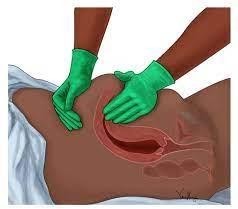A nurse is reinforcing teaching about risk factors for preeclampsia with a group of clients who are pregnant. Which of the following risk factors should the nurse include in the teaching?
Chronic hypertension
Maternal age of 30 years
Prepregnancy BMI of 19
Third pregnancy
The Correct Answer is A
A) Correct - Chronic hypertension is a significant risk factor for developing preeclampsia during pregnancy. Preeclampsia is characterized by high blood pressure and organ damage, typically occurring after 20 weeks of pregnancy.
B) Incorrect- Maternal age of 30 years is not a specific risk factor for preeclampsia.
However, maternal age over 40 is considered a risk factor.
C) Incorrect- A prepregnancy BMI of 19 falls within the healthy weight range and is not typically associated with an increased risk of preeclampsia.
D) Incorrect- Having a third pregnancy is not inherently a strong risk factor for preeclampsia. Women experiencing their first pregnancy are at a slightly higher risk.

Nursing Test Bank
Naxlex Comprehensive Predictor Exams
Related Questions
Correct Answer is C
Explanation
A) Incorrect- Taking the medication with breakfast may not ensure optimal absorption of iron, especially if the breakfast does not include a vitamin C source.
B) Incorrect- Taking the medication with the midday meal is not the best option for enhancing iron absorption.
C) Correct - Taking the medication with a glass of orange juice provides a source of vitamin C, which can improve iron absorption.
D) Incorrect- Taking the medication with milk is not recommended, as calcium in milk can interfere with iron absorption.
Correct Answer is D
Explanation
Rationale:
A) Incorrect - Applying oxygen is not the priority action in the case of excessive vaginal bleeding and a boggy uterus. Oxygen therapy would be appropriate if there were signs of respiratory distress or decreased oxygen saturation, but it does not directly address the primary concern of uterine atony and bleeding.
B) Incorrect - Administering methylergonovine might be appropriate, but the priority is to address the uterine atony with fundal massage first. Fundal massage helps stimulate uterine contractions and control bleeding, which is crucial in this scenario.
C) Incorrect - Encouraging the client to empty her bladder is important, but it is not the first action to take in the case of excessive bleeding and uterine atony. Immediate intervention to control the bleeding takes precedence.
D) Correct - Initiating fundal massage is the priority action in this situation. A boggy uterus with excessive vaginal bleeding indicates uterine atony, which is a potentially life-threatening condition requiring immediate intervention to prevent further bleeding.
Fundal massage helps the uterus contract and control bleeding. Addressing uterine atony is critical to prevent further hemorrhage and stabilize the client's condition.

Whether you are a student looking to ace your exams or a practicing nurse seeking to enhance your expertise , our nursing education contents will empower you with the confidence and competence to make a difference in the lives of patients and become a respected leader in the healthcare field.
Visit Naxlex, invest in your future and unlock endless possibilities with our unparalleled nursing education contents today
Report Wrong Answer on the Current Question
Do you disagree with the answer? If yes, what is your expected answer? Explain.
Kindly be descriptive with the issue you are facing.
